How to clean a stainless steel kettle outside and inside?

Housewives and chefs often choose stainless steel cookware for use in their kitchen. Such dishes have a unique and beautiful appearance that requires proper care. This article will tell you in detail about the means and folk advice you can use to get rid of scale and other contaminants on a stainless steel kettle.
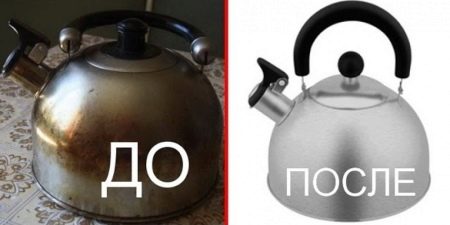
Types of pollution
The utensils used in the kitchen to cook or heat food and food are subject to various influences. The outer and inner surfaces of pots, pans or a kettle periodically endure heating to high temperatures, come into contact with various foods and substances.
The kettle, although it is used only for boiling water, unfortunately, also periodically becomes inadequate. You may encounter the following types of contamination in your stainless steel kettle:
- Scale traces. Mostly formed on the inner surface of cookware. If water often boils in the dishes and goes over the edge, then such traces can also affect the outer surfaces. The reason for their formation lies in the composition of the water, specifically, in the minerals and salts it contains.
When boiled, these elements evaporate from the water, but do not evaporate along with the steam, since they have too much mass for this. Therefore, on dishes in which water is periodically boiled, we can see whitish marks or plaque.


- Grease stains on the outer surface. Droplets of oil or grease can drip onto the kettle from pans on adjacent cooking zones. For example, if you are stirring foods to be fried in a pan. Often we do not attach importance to the fact that other dishes on the stove can also suffer from oil scattering during boiling.
- Black or brown carbon deposits... It is formed in cases when you did not keep track of the kettle and simply forgot to turn off the gas on time. Then the water overflows, forming dark spots on the outer surface and bottom of the crockery. If the liquid boils away completely, carbon deposits form inside the dishes.
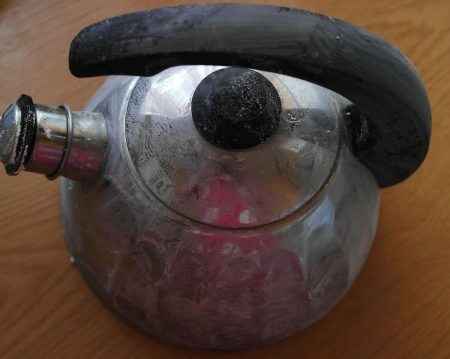
Cleaning methods
Still, do not be afraid and despair, because, as mentioned above, any dishes during use are prone to contamination and there is nothing to worry about. With the tips given below in this article, you can easily return your teapot to its original, beautiful and neat appearance:
- Laundry soap is a good and versatile means for washing teapots and other dishes, including colored ones. Lather a sponge dampened with water or prepare a soapy water solution and wipe down all surfaces of your utensils. Leave the kettle in the soapy water for 10 minutes, then rinse well with warm water.
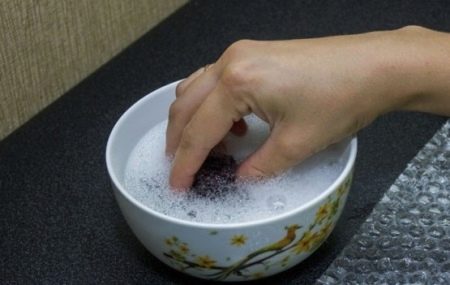
- You can clean the inside of the kettle from scale or carbon deposits using acidic solutions. As acidic compounds, you can use diluted lemon juice, a solution of apple cider vinegar, or citric acid. Table 6% apple cider vinegar should be diluted in water in a ratio of 1 tbsp. spoon per liter of water. Fill a kettle with this solution and bring the vinegar and water to a boil. After boiling, turn off the heat and wait for the water in the kettle to cool and become warm. After that, the inside of the kettle can be wiped with a soft sponge and rinsed with water.
Acids dissolve scale deposits and carbon deposits well.
- Lemon juice or citric acid can be used in a similar way. Citric acid is dissolved in water in a ratio of 1 teaspoon of acid crystals per liter of water. Lemon juice is added to 1 liter of water in the amount of 1 tablespoon.
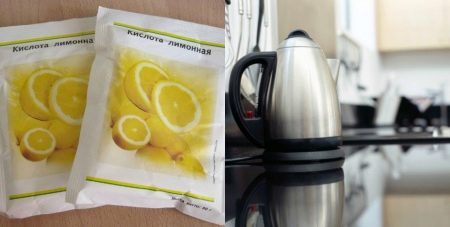
- You can use baking soda to remove grease, limescale or limescale from the outside of the kettle. Just avoid rubbing the surface of your stainless steel cookware with dry soda powder. This can damage the material and leave visible streaks. Soda should be diluted in a small amount of water to obtain a liquid gruel that resembles semolina or liquid sour cream.
This composition must be applied to the contaminated external surface with a sponge and evenly distributed. Leave the kettle covered with soda gruel for 15-20 minutes, then gently, without strong pressure, rub the surface with a wet sponge. Next, rinse the kettle under running water.
- You can wash off the traces of scale inside the kettle by boiling a soda solution in it. 1-2 tbsp. Dissolve tablespoons of soda in a liter of water. Bring this solution to a boil in your kettle. After cooling down, lightly rub the inner walls with a sponge and wash off the traces of soda.
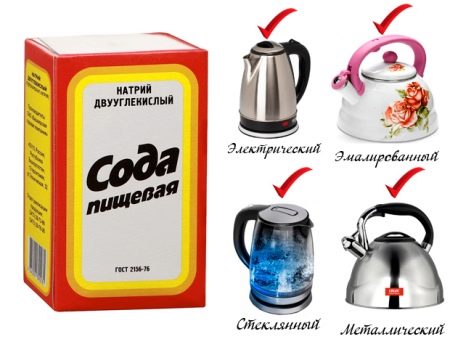
- The method, which is more related to popular advice, is the use of highly carbonated drinks with acids, such as Coca-Cola, Fanta, Sprite. If you fill the kettle with them and leave it for a while, you can notice how the scale begins to move away from the walls. If it doesn't, you can bring the carbonated drink to a boil in the kettle.
- Housewives often pour out pickle from pickled vegetables, not even knowing that it can also be successfully used in the fight against dirt on the inner surface of dishes, including stainless steel kettles. You need to fill the dishes with brine, bring it to a boil, reduce the gas and boil for 5-7 minutes. Limescale and small deposits inside the teapot can be easily removed with a sponge.
- You can always use special detergents for cleaning kitchen utensils, which are sold in the departments of household chemicals. Check the cleaning agent label to make sure it is suitable for cleaning your type of kettle. Follow the instructions when cleaning dishes with a cleaning agent.
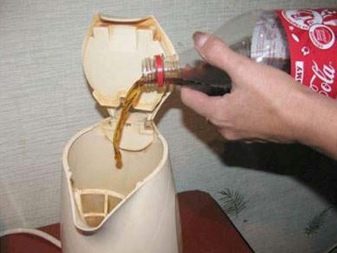
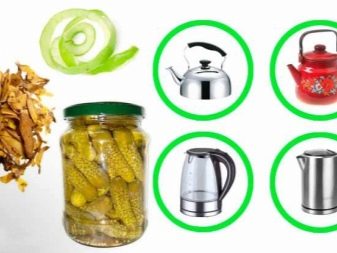
Prophylaxis
No matter how affordable and easy-to-follow methods for cleaning a stainless steel kettle at home are, it is still better to try to reduce the effect of contaminants on the dishes.Less contamination will reduce the frequency of cleaning your kettle, saving you time and effort.
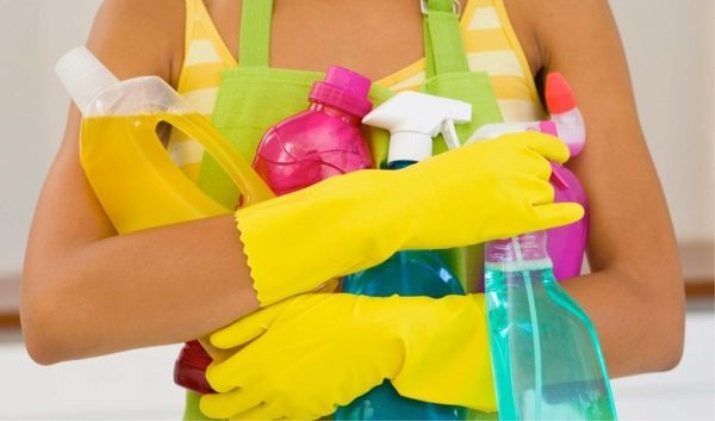
Here are some guidelines to help keep your kettle and other utensils clean in your kitchen for longer:
- Try to avoid boiling the same water several times. This significantly increases the deposition of salts and minerals on the walls of the dishes. Try to approximately calculate the amount of boiling water you need, or drain unused boiled water, using it for other needs.
- After each boiling and pouring water out of the kettle, it is advisable to wipe the inner surface with a wet, clean sponge. This is an easy and simple procedure that will take less than a minute, but it will help to remove the still invisible thin layer of scale on the walls.
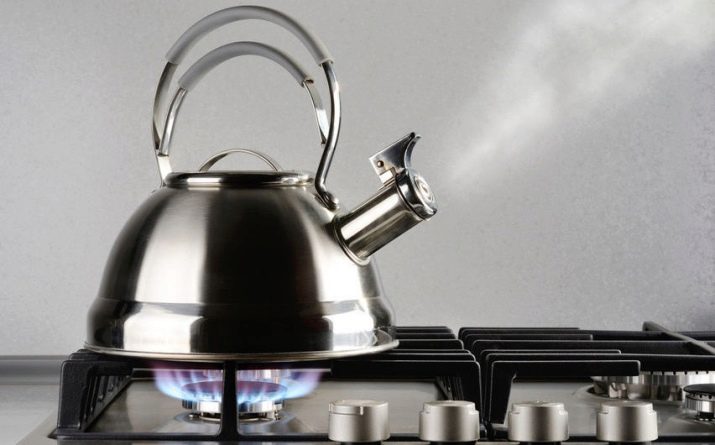
- To avoid getting boiling oil and grease or other food on the outside of the kettle, remove it from the stove when cooking on adjacent cooking zones. This is a very simple way to prevent greasy drops and stains on all types of dishes.
- If you have chosen chemical cleaners and formulations for cleaning dishes, it is worth taking care of hand protection. Be sure to use rubber gloves to protect your hands from possible allergic reactions or irritation.
- Wait until the kettle has cooled completely before washing. Do not allow colder water to fall on a hot surface. Temperature differences between stainless material and water can lead to micro deformations and damage to the steel. This advice applies to almost all types of metal and steel cookware.
We recommend watching the video, which shows an illustrative example of descaling in a kettle using citric acid.








